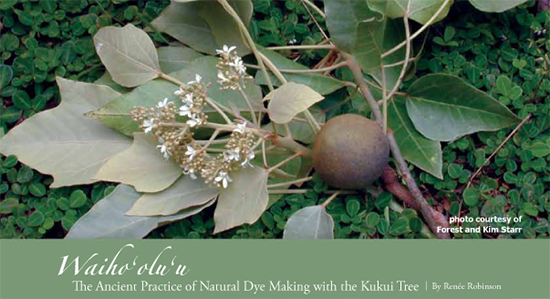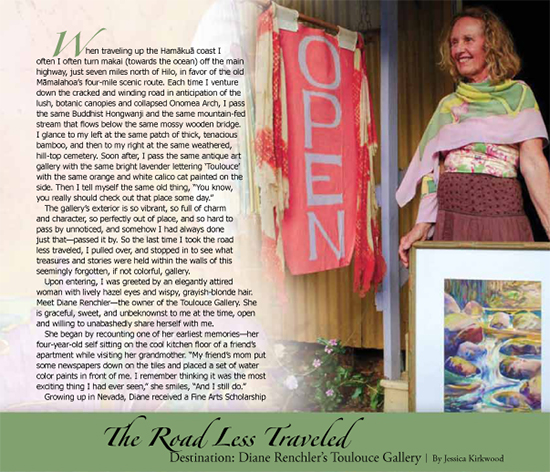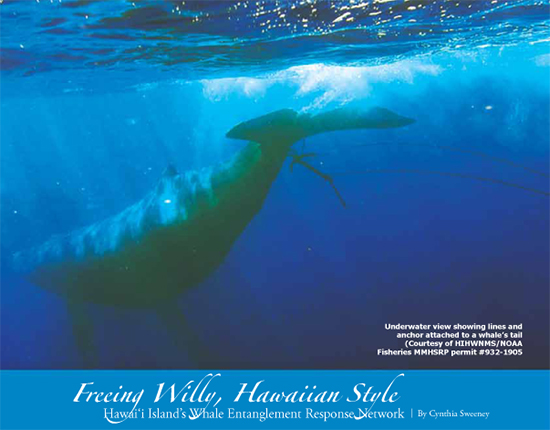
Loulu Palm Is On The Rebound
By Barbara Fahs
The Amy B.H. Greenwell Ethnobotanical Garden in Captain Cook doesn’t have a big neon sign that brags about its ongoing conservation efforts. Instead, Manager Peter Van Dyke and his small crew of helpers quietly go about the work of collecting seeds and propagating some of Hawai‘i’s most endangered species.
Amy Greenwell and the Garden
Established as part of the Bishop Museum in 1974, the Greenwell Garden is dedicated to the study of the Hawaiian people and their plants. Thanks to the efforts and generosity of botanist Amy Beatrice Holdsworth Greenwell, the land where the Garden is located was her gift to the people of Hawai‘i. She began her affiliation with the Bishop Museum in 1947, after contributing to a definitive book on Hawaiian plants titled Flora Hawaiiensis. Although she worked with Bishop Museum scientists on many archaeological projects, her heart and soul remained with the plants.
Upon her death at age 53 in 1974, Amy left her 15-acre ‘pre-Cookian’ garden property to Bishop Museum. It became the heir to the future ethnobotanical garden named in her honor. Scores of native and Polynesian-introduced plants were planted among intact remnants of Hawaiian agricultural formations according to the Bishop Museum website. The work continues to this day.
Carrying On with Greenwell’s Work
Since its inception, the garden has grown to include over 200 native Hawaiian plant species, many of which are on the federal endangered species list and some of which are extinct in the wild. Included in the long list of plants are: taro; kukui; hibiscus such as the extremely rare Koki‘o drynarioides; and several species of the only native Hawaiian palm tree, which belongs to the Pritchardia genus.
What Are the Pritchardias?
If you have seen the California fan palm (Washingtonia filifera), or the Mexican fan palm (Washingtonia robusta), you’ll have some idea what their “cousins,” the Pritchardias, look like. In Hawai‘i, the 24 known species of native Pritchardias are all called loulu (pronounced LOW-loo). However, the Palm and Cycad Societies of Australia website reports, “new Pritchardia species are still being found and described as recently as 2004 (P. flynii) and 1998 (P. perlmannii), both from Kaua‘i.”
Loulu is the Hawaiian word for umbrella, which is appropriate because Hawaiians of a bygone era commonly used the fronds as protection from rain. The Pritchardias are generally slow growing yet can attain heights between 25 and 60 feet or taller at maturity. Their canopy can extend from four feet for the miniature varieties, such as hillebrandii, to 15 feet for the larger species, such as schattaueri, making this tree a good choice for relatively small properties.
In his book, Loulu: The Hawaiian Palm, author Donald R. Hodel refers to the loulu’s flower clusters as “colorful,” the foliage “dramatic” and the fruit “conspicuous.”
Not all Pritchardia species are native to Hawai‘i. According to Van Dyke, the most common non-Hawaiian species are two from Fiji (P. pacifica and P. thurstonii). The following species are among those listed as endangered: P. affinis, aylmer-robinsonii, kaalae, napaliensis, remota, schattaueri viscosa, and the munroi, of which only two known individuals remain in the wild on Moloka‘i.
Traditional Uses of Loulu Palms
Because some of the taller species of loulu have very hard wood, it was fashioned into spears in historic times. All of the Pritchardias produce fruit similar to the coconut, yet smaller. The young fruit, which is called hāwane or wāhane, was peeled and eaten much as we eat the introduced coconut today. Loulu fronds, or lau hāwane, served as thatching material in ancient times and more recently they have been woven into pāpale (hats) and fans.
Why Do Plants Become Endangered?
“The pollen record suggests that there might have been large loulu forests in ancient times,” Van Dyke theorized. The Cambridge University International Journal of Conservation, Oryx, reports, “Eleven [Pritchardia] species are categorized as Critically Endangered, nine Endangered, two Vulnerable and one as Data Deficient… A large proportion of this genus is on the verge of extinction and will continue to decline in the wild without active conservation management.”
The Palm and Cycad Societies of Australia website reports, Hawai‘i’s “delicate ecosystem has not withstood the impacts of introduced animals and plants, and shares the tragedy of a high rate of extinction as well. The native palms, Pritchardia or loulu palms, are unique to Hawai‘i and the majority rank from vulnerable to critically endangered.” Before the arrival of the first Polynesians or other earlier settlers of the Hawaiian Islands, this Society believes, “most likely Pritchardia dominated the lowlands and interiors of the islands or it was at least a major forest component.”
The early introduction of rats, goats, deer, and pigs began a death sentence for many Hawaiian plants and animal species as well. Rats just love loulu fruit and the young seedlings that productive trees create. Pritchardias that grew in inaccessible areas, such as steep cliffs, stood a better chance of survival than those growing in places where rats found it easier to invade their territory and wipe out their chances of survival.
Conservation Projects
The Amy Greenwell Garden offers Pritchardias for sale to the public. Their plants are open pollinated, which means it is possible that they might be crossed with different species.
They propagate all of the trees they sell from their own specimen trees.
The Garden also provides plants to restoration projects, such as those that occurred at the 8,000-acre Kona Hema Nature Conservancy Preserve. For restoration projects, seeds are either collected from wild trees (a process that involves many governmental agencies and permits), or they are produced by controlled pollination, where the flower clusters are bagged to prevent inadvertent crosses.
Amy Greenwell Garden maintains a seed bank, where they store seeds of endangered Pritchardias and other native plants. It exists to keep old varieties of plants alive and make them available to growers and gardeners by preserving the seeds of various plants.
Growing Pritchardias in the Home Garden
Before 1998, Hawai‘i state law prohibited individuals from buying and growing endangered plants. Thanks to the efforts of botanists and conservationists, the law changed that year to open up home cultivation of special plants that are in danger of extinction.
Although it remains illegal to collect any species from the wild, more nurseries and growers are making available some species of Pritchardia and some other heritage plants.
If you purchase a Pritchardia palm tree at the Amy Greenwell Garden or other source, choose a species that is native to your part of the island. For example, the schattaueri species comes from South Kona’s inland areas. The affinis is also from Kona, and its range extended to coastal Ka‘ū and Kohala. The beccariana is a bit more common and hails from Puna. If you’re an adventuresome gardener who likes to experiment with “iffy” projects, you might consider planting a napaliensis. This endangered, miniature variety is native to the Nā Pali coast of Kaua‘i.
Loulu palms are generally fairly easy to grow and add a natural look to landscaping. Plant young loulu trees in deep, well-drained soil you have amended with compost: palms do not do well in soggy soil. However, keep newly planted trees well watered until they show signs of good growth. Snip off yellowing fronds and use them as mulch on the soil surface surrounding your loulu. Periodically add a shovel full of compost at the base to keep the roots well covered.
Controlling Insect Pests
Insect pests rarely attack the loulus, but whiteflies, spider mites, and scale can sometimes occur. Spray spider mites and whiteflies only with insecticidal soap, or hang sticky traps around your tree. For scale insects, mix insecticidal soap with cooking oil and spray every other day until all signs of the insects are gone.
The University of Hawai‘i Cooperative Extension Service reported in 2005 that the banana moth (Opogona sacchari) is perhaps the most dangerous pest to the loulus. When a loulu becomes weakened due to drought, wounds, flooding, or other environmental stresses, the female moth lays her eggs on the tree. When they hatch into caterpillars, they eat the plant’s living and dead tissues. Death can occur. The Cooperative Extension Service recommends using pyrethroid products and those containing Bacillus thuringiensis (Bt), a naturally occurring soil bacterium.
For more info:
Amy B.H. Greenwell Ethnobotanical Garden: 808.323.3318
Palm and Cycad Societies of Australia: pacsoa.org.au/palms/Pritchardia/PalmsOfHawaii.html
Loulu: The Hawaiian Palm
Kona Hema Preserve: Nature.org/ourinitiatives/regions/northamerica/unitedstates/hawaii/placesweprotect/kona-hema.xml
Hawaiian Native Plant Propagation Database: ctahr.hawaii.edu/hawnprop
Banana moth info: ctahr.hawaii.edu/oc/freepubs/IP-24.pdf
Contact writer Barbara Fahs: hiiakas.com


